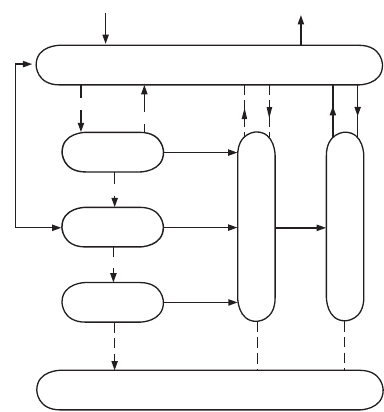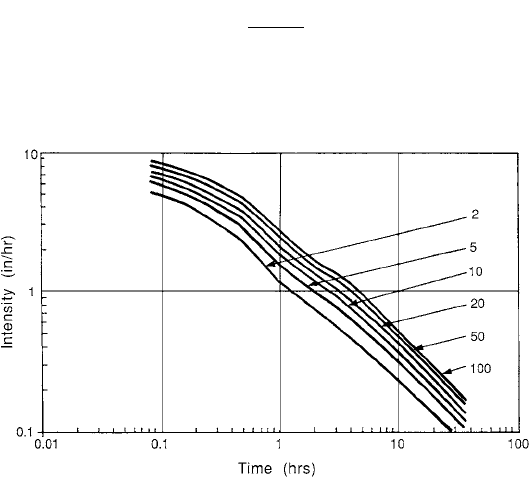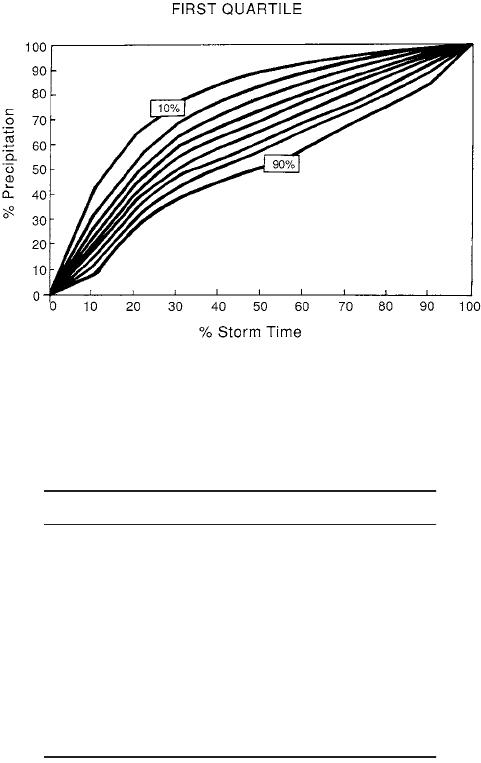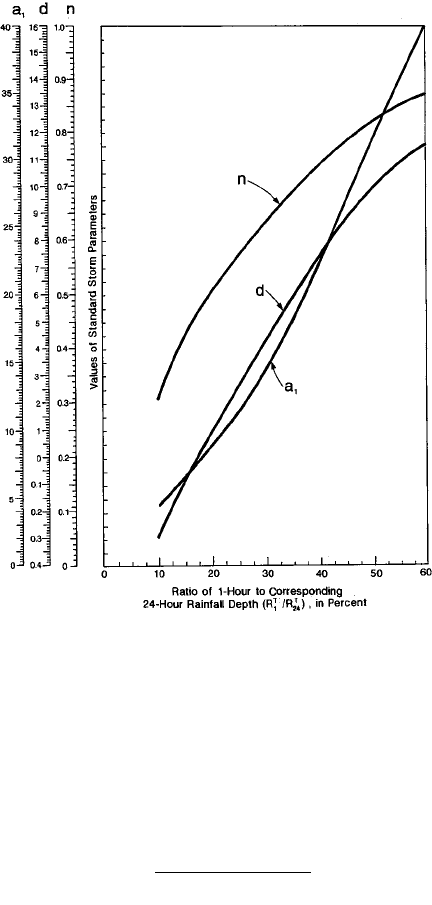Wai-Fah Chen.The Civil Engineering Handbook
Подождите немного. Документ загружается.


31
-2
The Civil Engineering Handbook, Second Edition
where
S
is the storage including the surface, soil moisture, groundwater and interception storage,
t
the
time.
I
(
t
) is the input, which includes precipitation in all its forms and
O
(
t
) is the output, which includes
surface and subsurface runoff, evaporation, transpiration, and infiltration.
According to the world water balance studies (UNESCO, 1978), about 127 cm of precipitation falls
on oceans of area 361.3 million km.
2
The corresponding values for land areas are 78.74 cm and
148.8 million km.
2
The evaporation rates are 55 and 19 in. respectively from the oceans and land areas.
Of the 12 in. of water that remains on land, 0.2 in. becomes groundwater and 11.8 inches reaches the
oceans as surface water. Due to the fact that a large part of the precipitation falling on the earth remains
as ice, the amount of surface water that is available for use is quite limited. In this chapter several aspects
of surface water hydrology are discussed.
Historical Development
Chow (1964) has classified the development of hydrology into eight periods. The first of these is called
the period of speculation (Ancient - 1400 AD) during which there were many speculations about the
concept of the hydrologic cycle. However, during this period, practical aspects of hydrologic knowledge
were studied and used to build civil works. During the period 1400 to 1600 AD (period of observation),
hydrological variables were simply observed. Leonardo da Vinci and Bernard Palissy understood the
hydrological cycle during this period. Hydrologic measurements started during the period of measure-
ment (1600–1700) and the science of hydrology may be said to have begun during this period. It continued
up to nineteenth century with experiments, a period called the period of experimentation (1700–1800).
The foundations of modern hydrology were laid during the period of modernization (1800–1900).
Hydrology was mostly empirical during the period of empiricism (1900–1930), which gradually gave
into the period of rationalization (1930–1960), during which theoretical developments in hydrograph,
infiltration and groundwater processes took place. The theoretical developments accelerated from 1950
to the present, a period called the period of theorization. The recent development of computers has made
it possible to construct and verify theories of increasing complexity, an endeavor that has become the
mainstay of modern hydrologic research.
FIGUREW 31.1
A systems representation of the hydrologic cycle. (From Dooge, 1973.)
INCOMING RADIATION
ATMOSPHERE
EVAPORATION
SURFACE
SURFACE
RUNOFF
INFILTRATION
OUTGOING RADIATION
R
i
R
b
E
P
SOIL
RECHARGE
LITHOSPHERE
GROUNDWATER
INTER-FLOW
RUNOFF
E
P
TRANSPIRTATION
CHANNEL NETWORK
OCEAN
?
?
?
PRECIPITATION
GROUND-
WATER
RUNOFF
© 2003 by CRC Press LLC

Surface Water Hydrology
31
-3
31.2 Precipitation
Atmospheric Processes
Air masses must be lifted and cooled for precipitation to occur. Air mass cooling can occur during the
passage of fronts when warm air is lifted over cooler air (frontal cooling); the passage of warm air over
mountain ranges (orographic cooling); or the lifting of air masses due to localized heating such as that
in the center of a thunderstorm cell (convective cooling).
As the air is cooled, water condenses on microscopic sized particles, called nuclei and this process is
called nucleation. Dust and salt particles are common condensation nuclei. Water particles resulting from
nucleation grow by condensation and by coming into contact with neighboring particles. They start to
descend as they become heavier and may coalesce with other water drops or they may decrease in size
during descent because of evaporation. If conditions are favorable, these water drops reach the ground
as rain, snow, or sleet. The particular form taken by precipitation is dictated by the atmospheric conditions
extant during the descent of water drops.
Measurement of Precipitation
Rainfall and snowfall are commonly measured. Both nonrecording and recording gages are used for
rainfall measurement. Recording rain gages are used to measure rainfall depth at predetermined time
intervals. These intervals can be as small as a minute. Nonrecording rain gages are read at larger time
intervals. Common recording rain gages are of the weighing, the tipping bucket and the float types. In
each of these, a record of rainfall depth against time is obtained. Depth and density of snow packs, in
addition to the water equivalent of snow, are also commonly measured, as these are useful in estimating
the water yield from snow packs. Measurement of snow depth is complicated because of the strong effect
of wind on snow (Garstka, 1964).
Temporal Variation of Precipitation
The unit of rainfall measurement is depth, in inches or millimeters. The rates are usually expressed as
in/hr or mm/hr, although longer durations such as days, months, and years are also used. Rainfall rate,
especially when the time duration is an hour, is called the intensity of rainfall. In general, rainfall intensity
is highly variable with time. A plot of intensity against duration is called a hyetograph of rainfall. A plot
of the sum of the rainfall depth against time is called as the mass curve. A mass curve whose abscissa
and ordinate are dimensionless is called the dimensionless mass curve. Typical hyetograph, mass curve,
and dimensionless mass curve are shown in Fig. 31.2.
Spatial Variation of Precipitation
Rainfall measurements are taken at different points in an area. The spatial structure of storms and their
internal variation cannot be adequately represented by a point measurement or even by many point
measurements made over a region. Consequently, there have been attempts to relate point rainfall
measurements to spatial average rainfall. As the area represented by a point measurement increases, the
reliability of the data from a point as a representative of the average over a region decreases. As drainage
areas become larger than a few square miles, point data must be adjusted to estimate areal data (Hershfield,
1961). If the drainage area is larger than 8 mi
2
, an area reduction factor is applied to the point rainfall
depth values obtained from the rainfall atlas (Hershfield, 1961). Recently there have been attempts to
measure rainfall by using radar.
Average Rainfall over an Area
The
arithmetic average
method, the
Thiessen polygon
method, and the
isohyetal
methods are commonly
used to compute average rainfall over an area. These and other methods have been investigated by Singh
and Chowdhury (1986) who concluded that they give comparable results, especially for longer storm
durations.
© 2003 by CRC Press LLC

31
-4
The Civil Engineering Handbook, Second Edition
Let the
average rainfall
over an area be
—
P
. Let the rainfall measured by
N
rain gages over an area
A
be
P
1
, P
2
,…
P
N
. The general expression for
—
P
is given in Eq. (31.2), where
W
j
are the weights.
(31.2)
Different methods of estimation of rainfall give different
W
j
values. For the arithmetic average, the
weights
W
j
are the same and are equal to (1/
N
). To compute the
Thiessen
average rainfall, the locations
of rain gages are joined by straight lines on a map of the area. These are bisected to develop a Theissen
polygon such that each rain gage with rainfall
P
j
is located in a part of a watershed of area
A
j
.
The sum
of areas
A
j
equal the watershed area
A
. The Thiessen weights
W
i
are given by
A
i
/
A
and
W
j
add up to unity.
The Thiessen average does not consider the spatial distribution of rainfall but takes into account the
spatial distribution of rain gages.
FIGURE 31.2
(a) Hyetograph: (b) mass curve; (c) dimensionless mass curve.
P
WP W
j=
N
jj j
=
()
Â
1
01, ,e
© 2003 by CRC Press LLC

Surface Water Hydrology
31
-5
In the
Isohyetal
method, lines of equal rainfall depth or
isohyetal lines
are first estimated. The variation
in rainfall between rain gages may be assumed to be linear for interpolation purposes. The areas
A
j
between isohyetal lines are measured and these add up to
A
. The number of areas enclosed within isohyets
is usually not equal to number of rain gages. The weights
W
j
are equal to
A
j
/
A
. The rainfall values
P
i
in
Eq. (31.2) are the average rainfall values between the isohyets. In the isohyetal method the spatial
distribution of rainfall variation is explicitly considered.
Intensity - Duration - Frequency (i-d-f) Curves
The largest rainfall depth measured over a specified duration, during a year, is an extreme value. Because
the durations are fixed, we will have a series of rainfall extreme values. For example, we will have extreme
rainfall depths corresponding to 30 min, 1 hr, 6 hr, etc. These extreme values — which are also the annual
maximum values in this case — are random variables denoted by
x
. The probability that x is larger than
a value
x
T
is called the exceedance probability and is indicated by
P
(
x
≥
x
T
) or
p
. The recurrence interval
T
is the average time elapsed between occurrences of
x
≥
x
T
. The
return period
or
recurrence interval
between
events exceeding or equalling
x
T
is the
average time
T
between exceedances of the event. The exceedance
probability and the return period are inversely related. The return period is also called the
frequency
.
By analyzing annual maximum rainfall intensities corresponding to a duration — such as 1 hr or 6
hr — the rainfall-intensity-frequency relationships are obtained. A set of rainfall intensity (i) frequency
(f) relationships corresponding to different rainfall durations (d) are called the intensity (i) - duration
(d) - frequency (f) curves. The i-d-f curves for Indianapolis, presented in Fig. 31.3, are typical of these.
It is difficult to use the i-d-f curves in computer analysis. Consequently, they are represented as
empirical equations such as Eq. 31.3 where i is the intensity in in./hr,
t
is the duration in hours,
T is the
frequency in years, and C and d are constants corresponding to a location and m and n are exponents.
For Indianapolis, C = 1.5899, d = 0.725, m = 0.2271 and n = 0.8797, and the resulting equation is valid
for durations between 1 and 36 hours.
(31.3)
These empirical equations give results that are more accurate than those obtained by interpolation of
graphs.
FIGURE 31.3 Intensity-duration-frequency curves for Indianapolis. (From Purdue, A.M., G.D. Jeong, A.R. Rao
[1992] “Statistical Characteristics of Short Time Increment Rainfall,” Tech. Rept. CE-EHE-92–09, School of Civil
Engineering, Purdue University, W. Lafayette, IN., pp. 64. With permission.)
i
CT
td
m
n
=
+
()
© 2003 by CRC Press LLC

31-6 The Civil Engineering Handbook, Second Edition
Dimensionless Mass Curves
To estimate hyetographs from rainfall depth-duration data, dimensionless mass curves are used. These
dimensionless mass curves are developed by classifying observed rainfall data into different quartiles. For
example, if the largest rainfall depth occurs during the first quartile of a storm duration then it is called
a first quartile storm. The cumulative rainfall in these storms is made dimensionless by dividing the
rainfall depths by the total rainfall depth and corresponding times by the storm duration. These dimen-
sionless mass curves of rainfall are analyzed to establish their frequencies of occurrence. These are
published in graphical form as shown in Fig. 31.4 and Table 31.1.
Given a rainfall depth and duration, the dimensionless mass curve information is used to generate
hyetographs. These hyetographs may be used as inputs to rainfall-runoff models or with unit hydrographs
to generate runoff hydrographs. The dimensionless hyetographs thus provide an easy method to generate
rainfall hyetographs (Purdue et al. 1992).
Chen (1983) developed a method of generating intensity-duration curves for different frequencies or
recurrence intervals. The method is based on 10 year - 1 hr, (R
1
10
), 10 year - 24 hr, (R
10
24
) and 100 year -
1 hr (R
1
100
)rainfall depths for the location of interest. These are available from the NWS publications such
FIGURE 31.4 Dimensionless first quartile cumulative rainfall curves for Indianapolis.
TABLE 31.1 Dimensionless Mass Curves (10% Level)
for Four Quartiles
% Storm Time I II III IV
0
10
20
30
40
50
60
70
80
90
100
0.00
42.00
64.35
76.36
83.84
89.63
92.50
95.00
97.00
98.57
100.00
0.00
16.36
32.73
58.10
76.36
87.50
92.54
95.69
97.00
98.67
100.00
0.00
14.36
25.26
33.33
41.82
54.72
78.18
92.35
96.43
98.73
100.00
0.00
19.35
30.00
36.36
43.53
50.00
54.55
63.64
82.50
96.73
100.00
© 2003 by CRC Press LLC

Surface Water Hydrology 31-7
as TP-40 or NWS HYDRO-35 or NOAA Atlas 2 in the U.S. (Hershfield, 1961; Frederick et al. 1977; Miller
et al. 1973). The intensity-duration-frequency relationship used in this study is of the form of Eq. (31.3).
In this method, the ratios, R
1
10
/R
10
24
and R
1
100
/R
1
10
= x are formed. The R
1
10
/R
10
24
ratio is the x axis of
Fig. 31.5, and by using this value, a
1
, d and n are read off from Fig. 31.5. The rainfall intensity corre-
sponding to duration t and recurrence interval T is estimated by using Eq. (31.4), where r
1
10
is the 10 year -
1 hour rainfall intensity which is the same as R
1
10
because the duration is 1 hour.
(31.4)
Chen’s (1983) method has been demonstrated to give very good estimates of rainfall intensity-duration-
frequency relationships.
Other Probabilistic Aspects
Numerous probabilistic models (Table 31.2) have been developed and used to characterize various rainfall
properties. For analyzing annual maximum rainfall data, log-normal and extreme value (III) distributions
have been successfully used. The Weibull distribution has been used to characterize the time between
precipitation events. Two parameter gamma distribution and bivariate exponential distribution have been
used to characterize the storm depths and durations. A discussion of these models is found in Eagleson
(1970) and Bras (1990).
FIGURE 31.5 Coefficients and exponents for use with Chen’s (1983) method.
t
T
xx
n
r
ar T
td
=
() ( )
+
()
--
11
10 2 1
10
log
© 2003 by CRC Press LLC

31-8 The Civil Engineering Handbook, Second Edition
31.3 Evaporation and Transpiration
Evaporation
Evaporation is the process by which water is removed from an open water surface. The rate of evaporation
depends on two factors: the energy available to provide the latent heat of vaporization, and the rate of
transport of water vapor from the water surface. Evaporation from ponds, rivers, and lakes depends on
solar radiation and wind velocity. The gradient of specific humidity, which is the ratio of the water vapor
pressure, e, to the atmospheric pressure, p, also affects the evaporation rate.
Evaporation from a body of water can be estimated by using the law of conservation of energy. By
using a control volume and estimating the energy inputs to and outputs from it, the evaporation rate E
1
(mm/day) can be shown to be as in Eq. 31.5, where R
w
is the net short wave radiation in W/m
2
,
(31.5)
where l
v
= the latent heat of vaporization (kJ/kg)
r
w
= the density of water in kg/m
3
.
In deriving Eq. (31.5), the sensible heat flux and the heat transfer from the water to the ground are
neglected. These assumptions are not realistic. Furthermore, there is no provision in Eq. (31.5) for
TABLE 31.2 Probability Distributions for Fitting Hydrologic Data
Distribution Probability Density Function Range Parameters
Normal
–• £ x £ •m, s
m =
–
x, s = s
x
Lognormal
x > 0 m
y
, s
y
m
y
=
–
y, s
y
= s
y
Gamma
x ≥ 0
l, b, e
Pearson Type III
(three parameter
gamma).
x, e
Log Pearson
Type III
log x, e
l, b, e
Extreme Value
Type I
–• < x < •
a, u
Fx
x
()
()
Ê
Ë
Á
Á
ˆ
¯
˜
˜
=-
-
1
2
2
2
2
sp
m
s
exp
fx
x
y
y
yx
y
()
=-
-
Ê
Ë
Á
ˆ
¯
˜
Ê
Ë
Á
Á
Á
ˆ
¯
˜
˜
˜
1
2
2
2
2
sp
m
s
exp
where = log
fx
xe
1x
()
=
()
=
--
b
bg
g
b
g
G
Gwhere function
lb b l,;==
Ê
Ë
Á
ˆ
¯
˜
2
2
x
s
x
s
x
x
fx
x
e
(x )
()
=
-
()
()
-
--
b
b
ge
g
e
b
1
G
lb
eb
==
Ê
Ë
Á
ˆ
¯
˜
=-
y
S
p
C
x
s
s
x
;
2
2
2
fx
y
e
x
yx
(y )
()
=
-
()
()
=
-
--
b
b
ge
g
e
b
1
G
where log
lbb
eb
==
È
Î
Í
Í
˘
˚
˙
˙
=-
s
C
ys
y
sy
y
;
2
2
fx
xu xu
()
=-
-
--
-
Ê
Ë
Á
ˆ
¯
˜
È
Î
Í
˘
˚
˙
1
aa a
exp exp
a
p
a
=
=-
6
0 5772
s
ux .
x
1
E
R
l
p
W
v
w
=
© 2003 by CRC Press LLC

Surface Water Hydrology 31-9
removal of water vapor from the water surface. To eliminate this strong drawback, Thornthwaite and
Holzman (1939) derived an equation which includes the wind velocity to estimate evaporation from
open water surfaces. This equation has been simplified for operational application and is given in
Eq. (31.6) (Chow et al. 1988). In Eq. (31.6), k is the von Karman constant, usually assumed to be 0.4, r
a
the density of air, (kg/m
3
) u
2
is the wind speed (m/sec) at height z
2
(r
w
is the density of water in kg/m
3
),
z
0
is a roughness height, p is the atmospheric pressure (Pa), e
sat
is the saturated vapor pressure (Pa) and
e the actual vapor pressure (Pa), E
2
is in mm/day.
(31.6)
Penman (1948) developed a comprehensive theory of evaporation and his equation involves both the
estimates E
1
and E
2
. The Penman evaporation estimate E is given in Eq. (31.7), where g is the psychro-
metric constant and D is the slope of the saturated vapor pressure curve at air temperature T
a
.
(31.7)
(31.8)
(31.9)
In Eq. (31.8) and Eq. (31.9), C
p
is the specific heat at constant pressure, K
h
is the heat diffusivity, K
w
is the vapor eddy diffusivity and the ratio (K
h
/K
w
) is usually assumed to be unity, and T is the temperature
(°C). Priestley and Taylor (1972) analyzed Eq. (31.7) and found that for evaporation over large areas,
the second term in Eq. (31.7) is about 30% of the first one. Based on this observation they developed
Eq. (31.10), the Priestley-Taylor Equation, which reduces the computations involved.
(31.10)
The Penman equation is the most accurate of all equations used to estimate evaporation from open
water surfaces. However, the data required to use it, such as solar radiation, humidity and wind speed
may not be easily available. In such cases, simpler evaporation equations (ASCE, 1973; Doorenbos and
Pruitt, 1977) are used.
Most commonly, evaporation is measured by using evaporation pans. The class A pan used in the U.S.
is 4 ft. (120.67 cm) in diameter and 10 in (25.4 (cm)) deep. The pan is made of Monel metal or of
unpainted galvanized iron. It is placed on a wooden support to facilitate air circulation beneath it. In
addition to the pan, an anemometer to measure the wind speed, a precipitation gage, thermometers to
measure water and air temperatures are also used. Water level in the pan is measured and reset to a fixed
level each day. The change in water level, adjusted to account for precipitation, is the evaporation which
has occurred during that day. Further details about evaporation pans used both in the U.S. and other
countries are found in WMO (1981).
The rates measured in evaporation pans are usually greater than those measured in larger water bodies.
The ratio of lake evaporation to pan evaporation is called the pan coefficient. To estimate evaporation
from a larger water body, the pan evaporation is multiplied by the pan coefficient. In the U.S., an average
pan coefficient is approximately 0.7, which varies with locations and at a location with seasons.
2
2
2
20
2
0 622
E
.
ku
pzz
ee
a
w
sat a
=
()
[]
-
()
r
r
ln
E
+
E
+
E
=+
D
DDg
g
g
12
g=
ph
vw
CK
p
0.622
lK
D
e
.+T
sat
=
()
4098
237 3
2
E.
+
E
= 13
1
D
Dg
© 2003 by CRC Press LLC

31-10 The Civil Engineering Handbook, Second Edition
Evapotranspiration
The process by which water in soil, vegetation, and land surface is converted into water vapor is called
evapotranspiration. Both the transpiration of water by vegetation and evaporation of water from soil,
vegetation and water surfaces are included in evapotranspiration. Because it includes water vapor gen-
erated by all the mechanisms, evapotranspiration plays a major role in water balance computations.
Consumptive use includes evapotranspiration and the water used by plant tissue. In practice evapotrans-
piration and consumptive use are used interchangeably.
The process by which plants transfer water from roots to leaf surfaces, from which it evaporates is
called transpiration. The rate of transpiration greatly depends on sunshine and on seasons and moisture
availability. Transpiration rates of different plant types vary. As transpiration ends up in evaporation,
transpiration rates are affected by the same meteorologic variables as evaporation. Therefore, it is com-
mon practice to combine transpiration and evaporation and express the total as evapotranspiration.
Potential evapotranspiration (PET) (Thornthwaite et al., (1944)) is a concept in common usage in
evapotranspiration computations. The evapotranspiration rate that occurs when the moisture supply is
unlimited is called the PET. The PET is a good indicator of optimum crop water requirements. The
concept of reference crop evapotranspiration (ET
0
) was introduced by Doorenbos and Pruitt (1977). The
reference crop evapotranspiration is similar to PET. The rate of evapotranspiration from an extended
surface of 8- to 15-cm tall green grass cover of uniform height, actively growing, completely shading and
not short of water is called the reference crop evapotranspiration. Thus, ET
0
is the PET of short green
grass which is the reference crop.
The PET is equivalent to evaporation from free water surface of extended proportions. However, the
heat storage capacity of this water body is assumed to be negligibly small. Consequently methods used
to estimate PET and evaporation are similar. Evapotranspiration and PET are based on (1) temperature,
(2) radiation, (3) combination or Penman, and (4) pan-evaporation methods. These are considered
below.
Blaney-Criddle formula (Eq. [31.11]), which is widely used to estimate crop water requirements is
typical of evapotranspiration formulas based only on temperature.
F = PT (31.11)
In Eq. (31.11), F is the evapotranspiration for a given month in inches, P is the ratio of total daytime
hours in a given month to the total daytime hours in a year and T is the monthly mean temperature in
degrees Fahrenheit. Doorenbos and Pruitt (1977) modified the Blaney-Criddle formula to include actual
insolation time, minimum relative humidity and daytime wind speed. Another well known temperature-
based evapotranspiration estimation method is that proposed by Thornthwaite et al. (1944). In this
method, the heat Index I
j
is defined in terms of the mean monthly temperature T
j
(°C). The annual
temperature efficiency index J is the sum of 12 monthly heat indices I
j
.
(31.12)
The potential evapotranspiration is computed by Eq. (31.13) and Eq. (31.14)
(31.13)
(31.14)
c = 0.000000 675 J
3
– 0.0000 771 J
2
+ 0.49239.
j
.
j
j=
j
I
T
J
I
=
Ê
Ë
Á
ˆ
¯
˜
=
Â
1 514
1
12
5
;
PET
K PET
*
=
0
0
16
10
PET
.
T
J
c
=
Ê
Ë
Á
ˆ
¯
˜
© 2003 by CRC Press LLC

Surface Water Hydrology 31-11
PET
0
is the PET at 0° latitude in centimeters per month. K
*
in Eq. (31.13) varies from month to month
and is given in Thornthwaite et al. (1944) and in Ponce (1989).
Priestley and Taylor (1972) developed a formula to compute PET, which is based only on the radiation
part of the Penman’s equation Eq. (31.7). Priestley and Taylor’s formula is given in Eq. (31.15).
(31.15)
The Penman equation is also used to calculate PET. Penman (1952) suggested the use of crop coeffi-
cients (0.6 in winter and 0.8 in summer) to compute the evapotranspiration rates. In pan evaporation
models, the PET is given by the formula Eq. (31.16), where K
p
is the pan coefficient and E
p
is the pan
evaporation.
(31.16)
The pan evaporation is widely used to estimate PET. Guidelines to choose appropriate pan coefficients
are found in Doorenbos and Pruitt (1977).
31.4 Infiltration
Process and Variability
Water on the soil surface enters the soil by infiltration. Percolation is the process by which water moves
through the soil because of gravity. As the soil exposed to atmosphere is not usually saturated, flow near
the ground surface is through unsaturated medium. The percolated water may reach the ground water
storage or it may transpire back to the surface.
As water travels from the surface to the groundwater, two forces act on it. The gravity forces attract the
flow towards groundwater and the capillary forces attract it to capillary spaces. Consequently, rate of per-
colation decreases with the passage of time and leads to decreasing rates of infiltration. Infiltration capacity
is the maximum rate at which infiltration can occur. The infiltration capacity f
p
is affected by conditions
such as the soil moisture. The actual rate of infiltration rate is f
i
. The infiltration rate and capacity are the
same when the rate of supply of water i
s
is equal to or greater than f
p
. Infiltration theories assume that i
s
is
equal to or greater than f
p
. Under these conditions, the maximum infiltration rate f
o
occurs at the beginning
of a storm and approaches a constant rate f
c
as the soil becomes saturated. The rate at which f
o
approaches
f
c
and the final value of f
c
depend on the characteristics of the soil and initial soil moisture (Fig. 31.6).
FIGURE 31.6 Infiltration curve.
PET
.
Rl
+
nv
w
=
()
1 260 D
D
r
g
PET
KE
pp
=
© 2003 by CRC Press LLC
